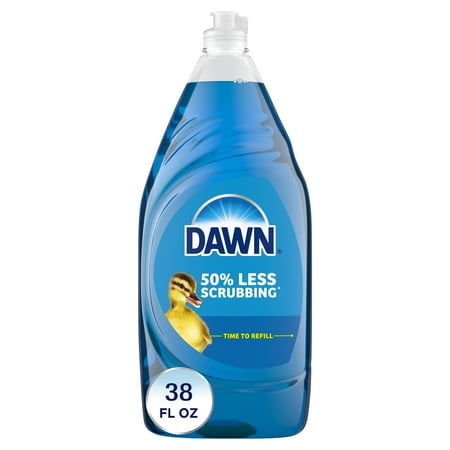Pest control pros reveal how to get rid of drugstore beetles quickly and stop them coming back
Found drugstore beetles in your dry goods? Our expert guide will help tackle them

Lola Houlton

When we open our pantries, we want to find an abundance of tasty foods and snacks – not pests and creepy crawlies such as drugstore beetles.
These tiny pests can quickly infest dried food goods such as four, cereals, and spices, making it essential to tackle the problem as soon as you spot them. Fortunately, with a few expert tricks, you can get rid of drugstore beetles and prevent them from coming back.
We talked to pest control pros who shared their top tips for getting rid of drugstore beetles quickly and explained how to pest-proof your pantry to prevent reinfestations in the future.
How to get rid of drugstore beetles quickly
1. Identify them
Before you start treating your pantry, kitchen or bathroom for drugstore beetles, you need to confirm that is what you are dealing with by identifying the pest properly.
James Agardy, technical and training manager and associate certified entomologist at Viking Pest Control says, 'Drugstore beetles are small (about 1/8th in long), cylindrical, brown insects. They will be found in the infested product and the surrounding areas. Sometimes small (1/8th inch) white, c-shaped grubs can be observed in the infested product.
'Inside homes, they are typically found in food products like flour, cereals, and dry pet food. They will also feed on pharmaceutical products which is how they got their name.'
If you suspect your house may have a drugstore beetle infestation you should also keep an eye out for larvae, although they may be difficult to spot with the naked eye. These will be small and white, but they will be really small so it may take a thorough search to weed them out.
Design expertise in your inbox – from inspiring decorating ideas and beautiful celebrity homes to practical gardening advice and shopping round-ups.
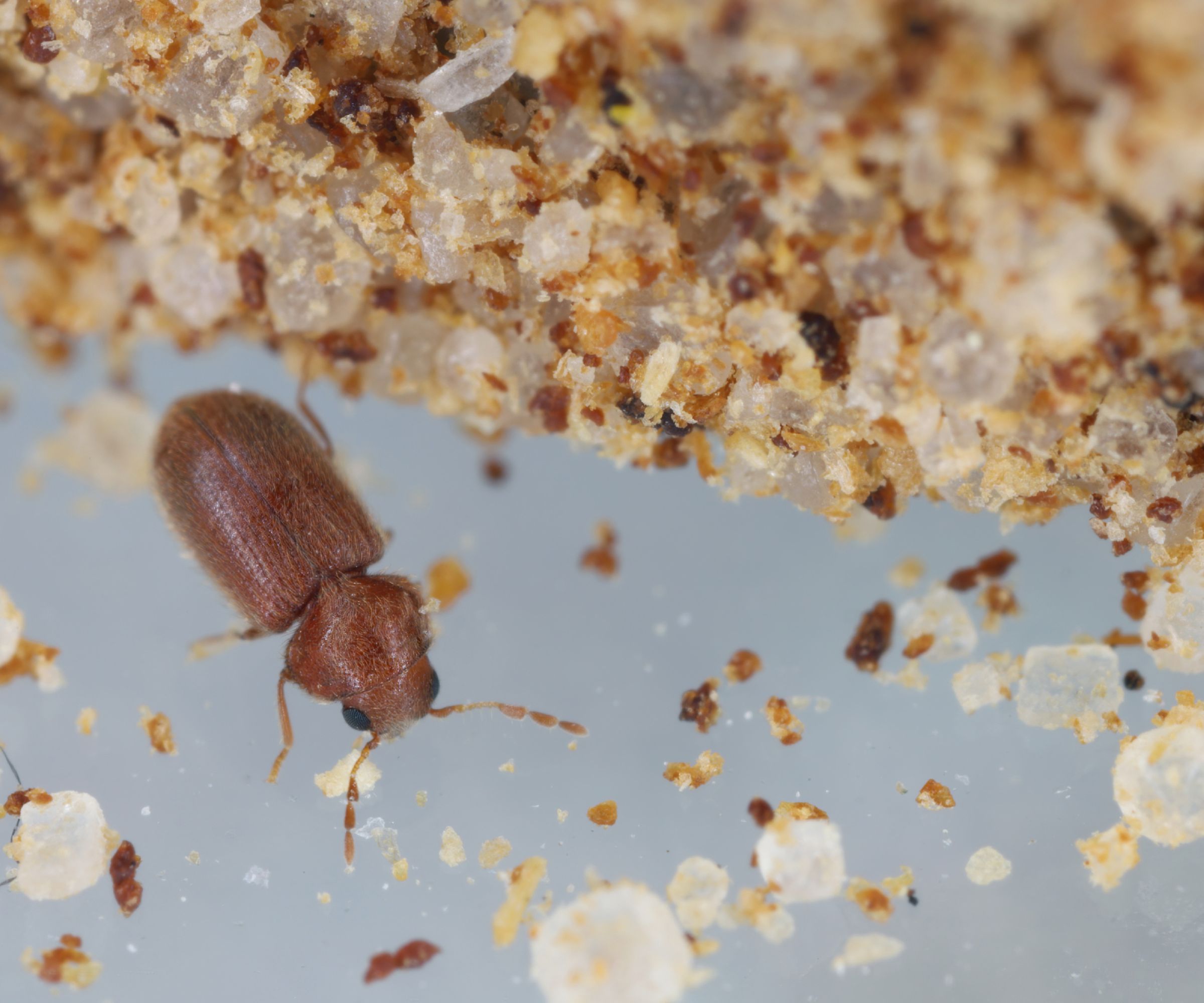
A drugstore beetle
Adult drugstore beetles will lay a mass of eggs, often on or near a food source, a common reason pests come inside homes. Learn more about how pests and insects get inside your home.
When hatched, drugstore beetle larvae exist in this form for four to five months and will eat their way through just about any food packaging. They are also not afraid to burrow their way through obstacles such as wooden doors to get to food, so it's important to get rid of them immediately to avoid any damage.
Mature drugstore beetles will live for about three to four weeks, at which time they may lay anywhere from 30 to 100 eggs. These insects can fly, too, which makes it easier for them to move around your kitchen or home, spreading the infestation.
2. Assess the scale of the infestation

A.H David from Pest Control Weekly says, 'The first step is identifying where the beetles are coming from. These beetles are especially attracted to food products like cereals, flour, spices, pet food, and other dry goods. Look for tiny beetles or their larvae, which appear as small, white worms. Keep an eye out for damaged packaging, as these beetles can chew through paper and thin plastic.'
Like getting rid of pantry moths, drugstore beetles are known to favor dark, temperate, and warm spaces. The first place you should check for drugstore beetles is in your pantry or food cupboards. In general, adult drugstore beetles pupate in small cocoons near where they or their larvae have been or eat.
Have a close inspection of any food products that are not sealed – even if there aren't any drugstore beetles in sight, they may have laid eggs in them.
2. Trash infested food goods
James Agardy, certified entomologist says, 'The first step in managing drugstore beetles is to find and dispose of the food source. Food items that may be infested can either be heated at 140° Fahrenheit for two to three hours, or frozen at 20° or less for a period of 48 hours. This will kill all life stages of the beetles.'
Although it may be frustrating, we'd recommend throwing away anything stored in the area where the drugstore beetles are or have been since it would be easy to miss a few larvae or beetles that can bring the infestation back around if not properly disposed of.
A.H David, pest expert, agrees, 'It's crucial to be thorough because even a small amount of overlooked food can sustain an infestation. Place all infested materials in a tightly sealed bag and promptly dispose of them in your outdoor trash can to ensure the beetles can't find their way back into your home.'
3. Vacuum the pantry thoroughly
A.H David, pest control expert continues 'Thoroughly clean your pantry and all storage areas. Start by vacuuming shelves, corners, and crevices to eliminate any larvae, beetles, and eggs. Pay close attention to cracks and crevices as these pests often hide in these places. After vacuuming, wipe down the areas with warm, soapy water.'
Knowing what to do after you've vacuumed a pest problem is also important, as you don't want to let any bugs back into your home. Always empty the dust bin of your best vacuum outside into a bag you can seal up before throwing it in your exterior trash bin.
4. Use pheromone sticky traps
Some beetles may remain even after vacuuming, To combat this, pest expert A.H. David recommends using pheromone sticky traps, such as Dr Killigan's Pantry Moth Traps at Amazon.
'Pheromone traps can be effective at reducing beetle populations. These traps contain a scent that attracts the beetles. When they approach, they become stuck to the adhesive inside. Replace the traps as they fill up and continue using them until you see no more beetles.'
Dispose of all used traps into your outdoor waste bin to protect your kitchen from any that manage to wriggle free. If you want to be double-sure, first bag them in a sealed bag, then dispose.
5. Treat the infested area with insecticide
While we love the use of natural homemade bug sprays, drugstore beetles need something a little stronger to kill them off. James Agardy, certified entomologist, says, 'Commercial treatment for the control of drugstore beetles consists of the application of pesticides and insect growth regulators into cracks and crevices of the areas where the beetles were observed.'
When applying a pesticide, assume they've climbed into any opening available when cleaning the space this means all the small cracks and crevices. We recommend an insecticide such Ortho Home Defense Insect Killer for Indoor, at Amazon, which has a wand applicator to help you target these smaller places and corners.
Evenly spray along the rest of the space. The Ortho Home Defense insect killer doesn't leave residue and is odorless, meaning you don't need to fumigate or clean the space again after using the spray. We do recommend using a mask when spraying and keeping clear of the space for a bit while it dries, however, to avoid irritating your airways.
This product should also create a bug barrier, keeping bugs away for up to 12 months.
How to prevent drugstore beetles
Preventing pests with natural pest-control methods and good food storage tricks is a must to prevent drugstore beetles from returning. Take away their food source and block entry points and you'll be on the right path.
A.H David begins, 'Firstly be on the lookout for them when buying food since they often work their way into packages prior to you buying them – so avoid purchasing food packages with rips in them.
When you have your food at home, place them into seal-able plastic or glass containers instead of their original packaging which is more likely to have or attract drugstore beetles since they are easier to get into. A.H. David adds, 'This strategy serves two purposes: it prevents beetles from getting in, and if any food is already infested, it confines the problem to that single container, making it easier to control.'
You might also want to fill in cracks that may be good hiding spots in cabinets and pantries. This can be done using the Loctite Tite Foam Gaps & Cracks Spray Foam Sealant, from Amazon.
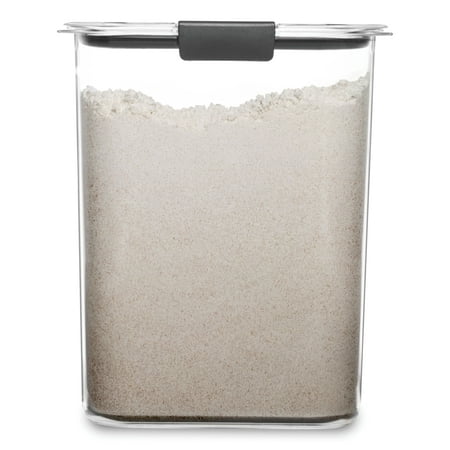
The rubbermaid glass food storage containers are hailed as some of the best food storage options for keeping food fresh and pest free
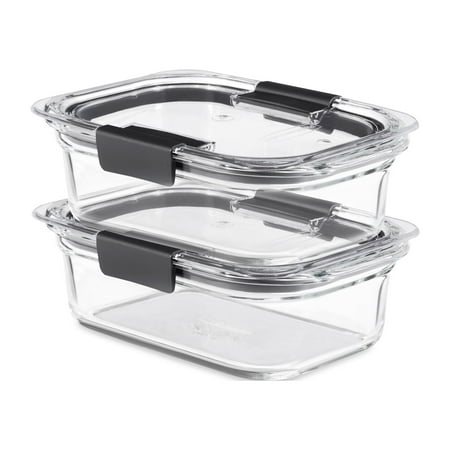
Glass food storage containers are BPA free, meaning they are safer than plastic, and can be used in the fridge, freezer, and microwave.
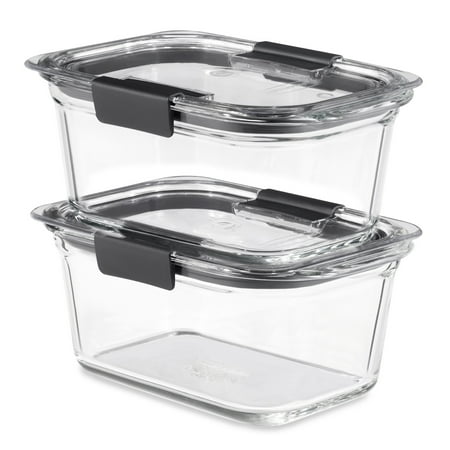
Picking all matching food storage containers is a great way to keep your pantry and cabinets organized without adding visual clutter to your kitchen. Glass also helps you see how much of a product you have left to minimize waste or over shopping.
Avoid leaving food open and forgotten about. This may mean avoiding bulk buying loads of food that will sit around for a while or simply organizing your pantry to keep tabs on what could attract drugstore beetles. You should also regularly clean and declutter a pantry. This means wiping up any messes as soon as they happen and not letting crumbs get into the cracks.
Finally, you may want to consider natural repellents to keep drugstore beetles away in the future. Zahid Adnan, founder of The Plant Bible says, 'These can include cedar blocks, bay leaves, or dried citrus peels placed in the storage areas. While these natural remedies may not completely eradicate an infestation, they can help discourage the beetles from settling in your pantry.'
Try a multipack of cedar blocks from Amazon for ease.
Although drugstore beetles are not harmful, they are destructive critters that can deplete your food resources as well as create an unhygienic environment with their eggs and feces. Following our expert-approved steps to spotting and banishing drugstore beetles can be a long-term solution to keep your food products bug-free.
If you aren't convinced these pesky insects have been banished, or you still spot signs of activity after you have cleaned and used insecticide on the areas in question, it is a good sign it's time to call professional pest controls in to help fumigate the area and deal with the problem for good with stronger chemicals.
| Row 0 - Cell 0 | Row 0 - Cell 1 | Row 0 - Cell 2 |
| Row 1 - Cell 0 | Row 1 - Cell 1 | Row 1 - Cell 2 |
| Row 2 - Cell 0 | Row 2 - Cell 1 | Row 2 - Cell 2 |

Chiana has been at Homes & Gardens for two years and is our resident 'queen' of non-toxic living. She spends most of her time producing content for the Solved section of the website, helping readers get the most out of their homes through clever decluttering, cleaning, and tidying tips. She was named one of Fixr's top home improvement journalists in 2024.
- Lola HoultonNews writer
